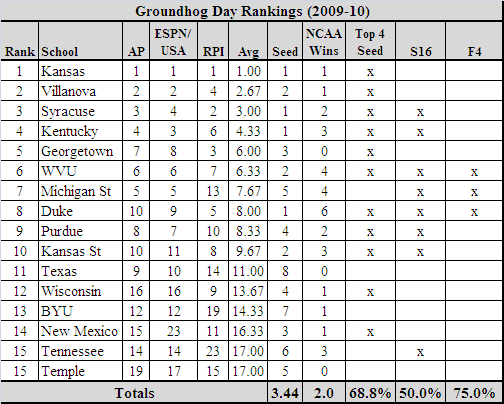Groundhog Day: Can It Predict March Success?
Posted by rtmsf on February 2nd, 2011Today is Groundhog Day, and with much of the nation under snow, ice and feeling a lot like the inside of a commercial freezer, it may seem very hard to believe, but Punxsatawney Phil actually predicted an early spring this year. Whether his prediction about March comes to pass is debatable, but it got us thinking that the celebration of his day makes for a good assessment point to see if what we think we know at this point of the season passes muster in less than six weeks. Generally speaking, do the teams ranked highly on February 2 do well in March? How predictive are the major polls today compared with what ultimately happens next month? We’re not sophisticated enough to run high-level regressions on this stuff, but we were able to eyeball some of the numbers and come to some basic conclusions below.
The first thing we did was look at the AP, ESPN/USA Today and the RPI ratings on or about Groundhog Day for the last three seasons. Notably absent are the Pomeroy ratings, but to our knowledge, he doesn’t keep historical daily archives available for public consumption. So we’ll deal with what we have. We then averaged the top sixteen teams using those three metrics and then compared them with their ultimate season outcomes (NCAA Tournament seed; Sweet Sixteen appearance; Final Four appearance). It’s a rudimentary analysis, but as you can see, below, Groundhog Day seems to be a fair to good predictor of March outcomes. Here are the last three years worth of data:
As you can see above, eleven of the sixteen teams ranked in the aggregate top sixteen ended up getting a top four NCAA seed, and a full half of these teams made it to the Sweet Sixteen. This year was the only incident in the three-year window where a Final Four team (Butler) came from outside the Groundhog Day top 16. On to 2008-09:











































